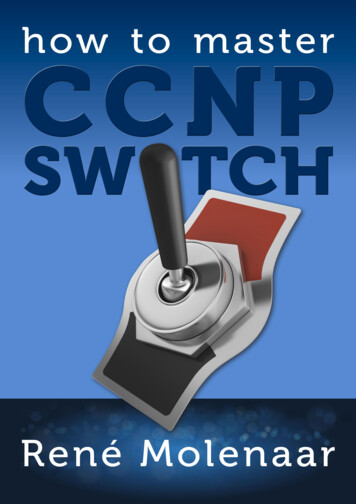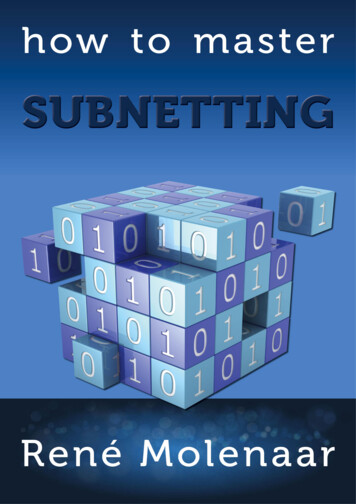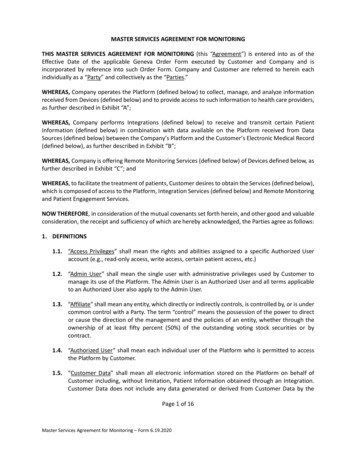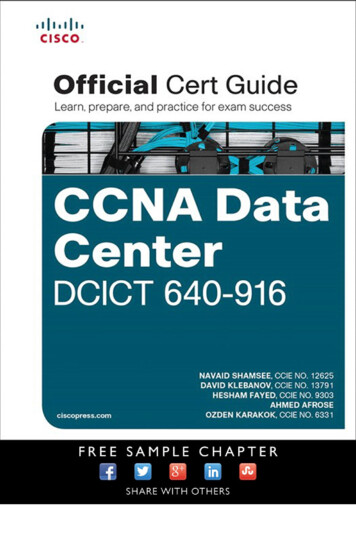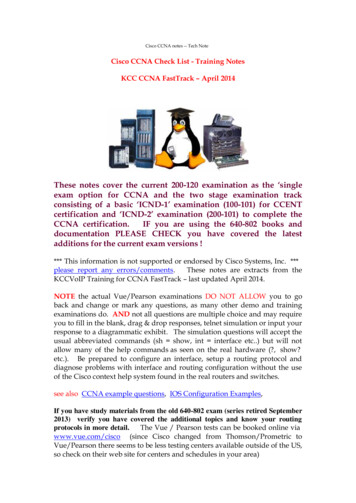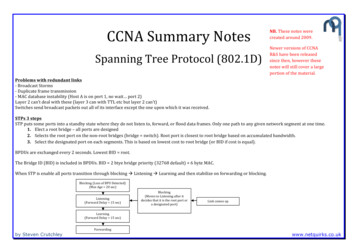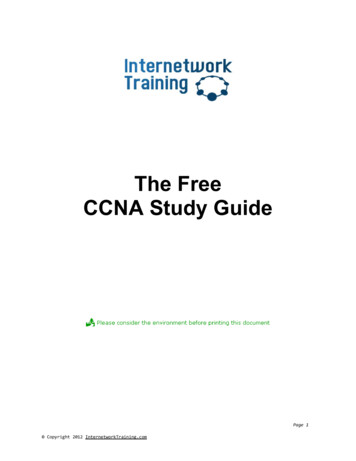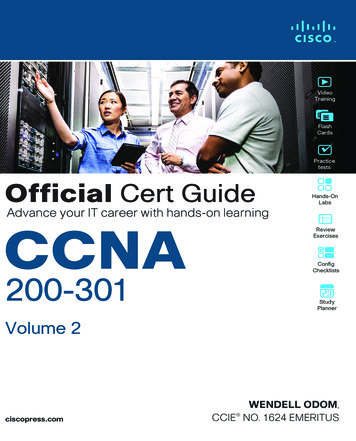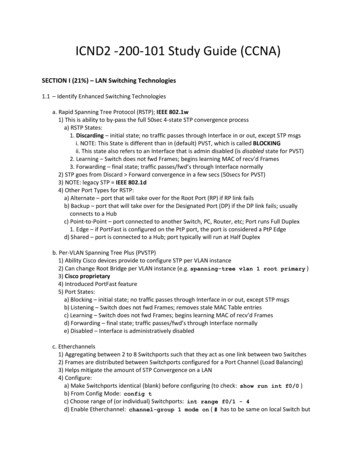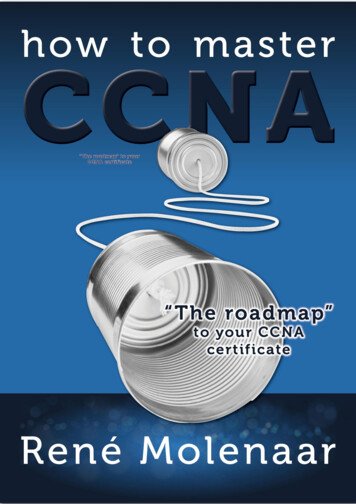
Transcription
How to Master CCNAAll contents copyright C 2002-2013 by René Molenaar. All rights reserved. No part of thisdocument or the related files may be reproduced or transmitted in any form, by any means(electronic, photocopying, recording, or otherwise) without the prior written permission ofthe publisher.Limit of Liability and Disclaimer of Warranty: The publisher has used its best efforts inpreparing this book, and the information provided herein is provided "as is." René Molenaar.makes no representation or warranties with respect to the accuracy or completeness of thecontents of this book and specifically disclaims any implied warranties of merchantability orfitness for any particular purpose and shall in no event be liable for any loss of profit or anyother commercial damage, including but not limited to special, incidental, consequential, orother damages.Trademarks: This book identifies product names and services known to be trademarks,registered trademarks, or service marks of their respective holders. They are usedthroughout this book in an editorial fashion only. In addition, terms suspected of beingtrademarks, registered trademarks, or service marks have been appropriately capitalized,although René Molenaar cannot attest to the accuracy of this information. Use of a term inthis book should not be regarded as affecting the validity of any trademark, registeredtrademark, or service mark. René Molenaar is not associated with any product or vendormentioned in this book.GNS3Vault.com – René MolenaarPage 2 of 466
How to Master CCNAIntroductionOne of the things I do in life is work as a Cisco Certified System Instructor (CCSI) and afterteaching CCNA for a few years I‟ve learned which topics people find difficult to understand.This is the reason I created http://gns3vault.com where I offer free Cisco labs and videos tohelp people learn networking. The problem with networking is that you need to know whatyou are doing before you can configure anything. Even if you have all the commands youstill need to understand what and why you are typing these commands. I created this bookto give you a compact guide which will provide you the answer to what and why to help youmaster the CCNA exam.I have tried to put all the important keywords in bold. If you see a term or concept inbold it‟s something you should remember / write down and make sure you understand itsince its core knowledge for your CCNA!One last thing before we get started. When I‟m teaching I always advise students to createmindmaps instead of notes. Notes are just lists with random information while mindmapsshow the relationship between the different items. If you are reading this book on yourcomputer I highly suggest you download “Xmind” which you can get for free here:http://xmind.netIf you are new to mindmapping, check out “Appendix A – How to create mindmaps” at theend of this book where I show you how I do it.I also highly recommend you to follow me along when I‟m demonstrating the configurationexamples. Boot up GNS3 and/or your switches and configure the examples I‟m showing youby yourself. You‟ll learn more by actively working on the equipment compared to justpassive reading.Enjoy reading my book and good luck getting your CCNA certification!P.S. If you have any questions or comments about this book, please let me com – René MolenaarPage 3 of 466
How to Master CCNAIndexIntroduction . 31. Lab Equipment . 52. Basics of networking . 103. The OSI-Model . 164. The network layer: IP Protocol . 245. The Transport Layer: TCP and UDP . 406. Ethernet: Dominating your LAN for over 30 years . 487. Introduction to Cisco IOS . 588. Hubs, Bridges and Switches . 879. Virtual LANs (VLANs), Trunks and VTP . 10210. Etherchannel (Link Aggregation) . 14311. Spanning-Tree (STP) . 15212. Binary, Subnetting and Summarization. . 18313. IP Routing . 20814. FHRP (First Hop Redundancy Protocols) . 22915. Distance Vector Routing Protocols . 24916. OSPF – Link-state routing protocol . 26417. EIGRP – Cisco‟s Hybrid Routing Protocol . 29418. Security: Keeping the bad guys out. . 31219. Network and Port address Translation (NAT & PAT) . 33020. Wide area networks . 34221. Introduction to IPv6 . 37922. IPv6 NPD and Host Configuration . 40023. IPv6 Routing . 40924. Virtual Private Networks . 42525. Network Management . 43326. IOS Licensing . 45727. Final Thoughts. 464Appendix A – How to create mindmaps . 465GNS3Vault.com – René MolenaarPage 4 of 466
How to Master CCNA1. Lab Equipment“If I had eight hours to chop down a tree, I'd spend six hours sharpening my ax” Abraham LincolnBefore we are going to start on our networking journey we will take a look at thenetworking equipment that you will need. If you want to master the CCNA exam you‟ll haveto do two things: Read this book so you learn about all the different protocols and understand thetheory.Implement your knowledge by configuring these protocols on our routers andswitches.So what equipment should you get?For most of the labs you can use GNS3. This is an emulator that runs the Cisco IOSsoftware but you can only emulate routers no switches. You can download GNS3 forfree from http://gns3.net but you‟ll have to supply the IOS image yourself. Cisco owns thecopyright on IOS so it can‟t be shared freely. I suggest using the 3640 or 3725 router inGNS3.Courtesy of Cisco Systems, Inc. Unauthorized use not permitted.The closest you can get to emulate a switch in GNS3 is inserting this NM16-ESW Etherswitchmodule in your virtual router.It adds 16 switch ports to your virtual router and supports basic switching features.Unfortunately this module is very limited and I don‟t recommend using it for CCNA.GNS3 isn‟t very difficult to work with but there is one thing you need to be aware of. Mostpeople complain that whenever they start an emulated router that they see their CPU jumpto 100%. You can fix this by setting a correct IDLEPC value. If you are configuring GNS3you need to check this video where I explain you how to do it:https://www.youtube.com/watch?v NkEv6v6rqlAGNS3Vault.com – René MolenaarPage 5 of 466
How to Master CCNASo what do we need? My advice is to use GNS3 for all your routing labs and buy somereal physical switches for the switching labs. Don‟t be scared I‟m not going to adviseyou to buy ultra-high tech brand new switches! We are going to buy used Cisco switchesthat are easy to find and they won‟t burn a hole in your wallet Without further ado here are our candidates:Courtesy of Cisco Systems, Inc. Unauthorized use not permitted.Cisco Catalyst 2950: This is a layer 2 switch that does everything you need for CCNA.If you look at eBay you can find the Cisco Catalyst 2950 for around 30. It doesn‟t matter ifyou buy the 8, 24 or 48 port model. Not too bad right? Keep in mind you can sell them onceyou are done with CCNA without losing (much) money. This switch is cheap and perfect forCCNA! Once you have your switches you should connect them like a0/FaFa00/FaFaFa0/Fa0 13/142950SwitchAFa0/16Fa0/172950SwitchCIf you plan to study CCNP after completing CCNA I can highly recommend swapping oneCisco Catalyst 2950 for a Cisco Catalyst 3550.GNS3Vault.com – René MolenaarPage 6 of 466
How to Master CCNACourtesy of Cisco Systems, Inc. Unauthorized use not permitted.Cisco Catalyst 3550: It offers pretty much the same features as the 2950 but it alsosupports routing which we require for CCNP.What about other switch models? Anything else we can use for CCNA? The Cisco Catalyst 2960 is the successor of the Cisco Catalyst 2950, it‟s a great layer2 switch but more expensive.The Cisco Catalyst 3560 is the successor of the Cisco Catalyst 3550, it also offersrouting features but it‟s quite more expensive around 300 on eBay.The Cisco Catalyst 3750 is also a switch that can do routing but it‟s very expensive.My advice is to get the 3x Cisco Catalyst 2950 or 2x Cisco Catalyst 2950 and 1x CiscoCatalyst 3550 if you want to study CCNP after your CCNA.Are there any switches that you should NOT buy? Don‟t buy the Cisco Catalyst 2900XL switch; you‟ll need at least the Cisco Catalyst2950 switch. Many features are not supported on the Cisco Catalyst 2900XL switch.Don‟t buy the Cisco Catalyst 3500XL switch, same problem as the one above.You also have to buy some cables:GNS3Vault.com – René MolenaarPage 7 of 466
How to Master CCNAAbove you see the blue Cisco console cable. It probably comes with the switch but makesure you have at least one. You‟ll need this to configure your switches.If your computer doesn‟t have any serial ports to connect your blue Cisco console cable youneed to get one of these. It‟s a USB to serial port converter.Courtesy of König Electronic Inc. Unauthorized use not permitted.I also like to use one of these. It‟s a USB connector with 4x RS-232 serial connectors youcan use for your blue Cisco console cables to connect to your switches.It saves the hassle of plugging and unplugging your console cable between your switches.The one I‟m using is from KÖNIG and costs around 30. Google for “USB 4x RS-232” andyou should be able to find something similar.Between the switches you‟ll require UTP cables. There‟sa difference between straight through and crossovercables (we‟ll talk about that later in the book). Modernswitches and network cards support auto-sensing so itreally doesn‟t matter what kind of cable you use.If you are going to connect your 2950 switches to eachother make sure you buy crossover cables since theydon‟t support auto-sensing!GNS3Vault.com – René MolenaarPage 8 of 466
How to Master CCNAIt will be useful if you have one old extra computer or laptop that you can use to connect toyour switches.Now you know the equipment that you need, it‟s time to dive into networking!GNS3Vault.com – René MolenaarPage 9 of 466
Do you enjoy reading this sample of How to Master CCNA ?Click on the link below to get the full version.Get How to Master CCNA Today
How to Master CCNA2. Basics of networkingBefore we start digging into complex stuff we‟ll have a little talk about networks.What is a network anyway?A network is just a collection of devices and end systems connected to each other and ableto communicate with each other. These could be computers, servers, smartphones, routersetc. A network could be as large as the internet or as small as your two computers at homesharing files and a printer.Some of the components that make up a network: Personal Computers (PC): These are the endpoint of your network, sending andreceiving data.Interconnections: These are components that make sure data can travel from onedevice to another, you need to think about:o Network Cards: they translate data from your computer in a readable formatfor the network.o Media: network cables, perhaps wireless.o Connectors: the plug you plug in your network card.Switches: These boxes are network devices which provide a network connection foryour end devices like PC‟s.Routers: Routers interconnect networks and choose the best path to each networkdestination.If you are going to work with Cisco you‟ll have to get used to some network diagrams likethe one a1S0/0RouterSo what do we see in the network diagram above? First of all we see a computer connectedto a switch. On the switch side you see “Fa0/1” which means the computer is connected tothe FastEthernet 0/1 interface on the switch side. The 0 is the controller number (usually 0on smaller switche
25.01.2013 · mindmaps instead of notes. Notes are just lists with random information while mindmaps show the relationship between the different items. If you are reading this book on your computer I highly suggest you download “Xmind” which you can get for free here:

